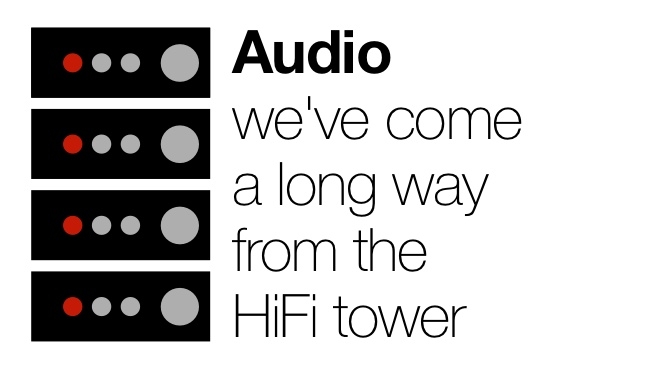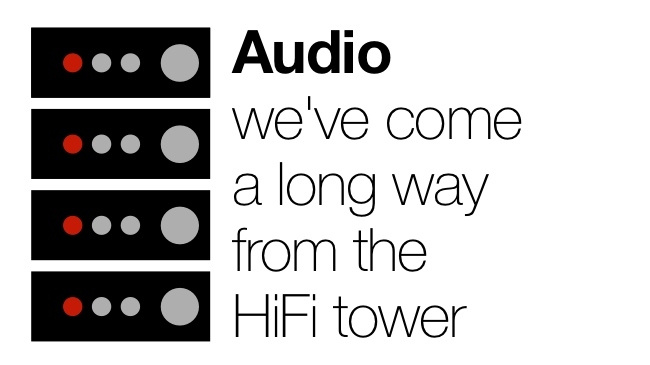
 Audio - we've come a long way from the HiFi tower
Audio - we've come a long way from the HiFi tower
Over the span of two decades entertainment has evolved from a physical to a virtual industry. Guest author Gabriel Dusil explores how our world of entertainment has evolved and what happened to the once-prestigious Hi-Fi tower.
When I was a teenager, the crowning achievement of audio enthusiasts was to proudly display their Hi-Fi system to their friends. The living room centerpiece was a Hi-Fi tower, built from what are called separates - units manufactured as 19-inch appliances with a brushed aluminum facade. This was the 70s and the Hi-Fi tower consisted of an amplifier, radio tuner, tape player and a turntable that took top position in the penthouse suite. For the baby boomer with higher disposable incomes, the tower may also exhibit a pre-amp, maybe even an equalizer for good measure. In 1982, the audio industry added a CD player and the world was introduced to digital sound. Then, in 1995, the DVD player joined the portfolio and digital video moved into the mainstream.
End of an Era
We were proud of our appliances and displayed them as beautiful fixtures in our living rooms. But by the mid-90s, the audio industry began to change. The emergence of the World Wide Web started to affect our entertainment habits. The MP3 format, an audio coding format for digital audio, was standardized in 1993 and soon became a tool that disrupted the audio industry. It allowed consumers to save music onto their computers at a fraction of the size compared to a CD. Then, Peer to Peer (P2P) networking was popularized by the notorious Napster service, launched in 1999 allowing everyone to share their MP3 music libraries - albeit illegally. Music may have turned digital with the CD, but it also morphed from a physical product to a virtual one. When collections moved to hard drives, the CD player began to lose its lustre. By the end of the 20th century, the portable media player using hard drives or flash drives began to emerge.
It wasn't just the audio and video input sources that evolved. By the first decade of 2000, the output changed as well. Active speakers began to eat into the market share of passive speakers, lessening the need for an amplifier. Much of this was driven by the computer industry, where speakers would connect directly to the PC. The cornerstone of the Hi-Fi tower was in jeopardy. But the consumer electronics industry seemingly compensated. They continued to improve on the Class D amplifier design, which was more power efficient, dissipated less heat and cheaper to produce than their Class A to C counterparts. They also began to support video inputs. With video, this appliance evolved into the Audio-Visual Receiver. This may have extended the validity of the amplifier, but by the 2000s, the Hi-Fi tower began to lose many of its floors.
The turntable almost disappeared once the CD began to reach critical mass. I trashed mine sometime around 1993. But vinyl has had a resurgence of interest from die-hard fans that are convinced that records sounds better. My take on this is that vinyl enthusiasts are accustomed to the fidelity limitations that the media imposes on audio frequency and resolution. In fact, that 'warm' sound that is much loved can be easily reproduced through digital filters (please, no nasty letters). Tape decks have long become occupants of landfills. I finally threw mine out around 2005, even though I hadn't used it for a decade. The graphic (or, more likely, parametric equaliser) may still be present in recording studios, but is predominantly a software feature in digital audio. In fact, today's audio quality is so pristine that the consumer want for an equalizer has virtually disappeared.
Most consumers can't tell the difference between a 192kbps and a 320kbps MP3 track at 44.1KHz and 16bit resolution on a stereo channel. Consider that Blu-Ray tracks can support up to 24.5Mbps, 96kHz, 24bit resolution on 7.1 channels. That's 76 times more information delivered to your ears! The additional surround channels are apparent, but most consumers don't hear the additional resolution. Regardless, the audio industry can't stand still; it needs to evolve. As the video industry begins to standardize on 4K UHD technology, audio giants such as DTS and Dolby Digital will need to step up their game and improve on their DTS-HD and Dolby TrueHD standards. Possibly, Dolby Digital Atmos is the future, which currently supports up to 128 audio tracks and 64 speakers. But how this technology will fits into a home theater set-up remains a question.
Black Boxes to Virtual Boxes
By 2006, the first Blu-Ray discs were released. It became a new floor in our tower. But many argue that it may be the last, in favor of internet streaming. Online video streaming services have had a negative effect on disc players. Consumers realized that access to a large library at a low monthly cost makes more sense than owning shelves of CDs, DVDs or Blu-Rays. Today's internet has plenty of bandwidth to support video streaming. As long as subscribers can continue to access content easily through a cloud-based service, then there will be little desire for ownership.
Has the 19" appliance been replaced by software? The limitation of this audio black-box appliance is certainly apparent in today's demanding multi-functional world. Today's consumers expect some combination of Bluetooth, Wireline, WiFi, DLNA20 connectivity or Near Field Communication (NFC) in their consumer electronics. For example, a disc player that can't connect to the Internet has little value to an Internet savvy consumer. A console that doesn't support multi-player gaming over the internet is boring.
Video, audio and communication is integral to today's gamer. My kids use their PC to connect to Skype and have group chats when playing DayZ, Minecraft or World of Tanks. They use LogMeIn Hamachi to network their computers. They record their gaming experience with Camtasia Studio and share it on their YouTube channel. Many games are not even suitable for disc release. Assassins Creed Unity' for example, is a 42GB download on Ubisoft's Uplay!
Millennial Entertainment
My audio-visual setup is quite unusual. I don't have a living room in the traditional sense. My computer has become the center of both my work and entertainment world. I sit two feet away when I need to type on the keyboard. Then, I move ten feet away to watch movies. My office is my living room and vice-versa. I appreciate that this is not typical for the majority of households, but certainly some level of convergence is happening on a larger scale. TVs are now Smart and connected to the Internet. Computers, tablets and mobiles are being used to watch entertainment. Gaming consoles are used for social networking. Many consumers don't realize that their Set-Top-Box (STB) from their cable provider is a PC.
Where does that leave us? For starters, let's accept that the beautiful Hi-Fi tower, as we once knew it, has virtually disappeared. Millennials don't even know what they look like. My tower was dismantled shortly before my kids were born. Even the receiver, once the cornerstone of my Hi-Fi tower, was shelved in favor of active speakers.
Modern living rooms still have their appliances. Somewhere in the house will be a WiFi router. The STB may sit beside a gaming console and maybe a connected Blu-Ray player. A select few will have a media player or a home theatre PC (HTPC). But each one will have a different shape, color and size. Nothing in this setup has the elegance of Hi-Fi tower. Even though some manufacturers try to maintain the 19" form factor, it doesn't quite have the same ta'da' enthusiasm from my youth. If a Hi-Fi tower does exist, they are found in high-end home theatres, hidden behind walls, cabinets or doors.
Thanks for the Memories
Today's digital society was elegantly summarized by Cory Bergman, from Lost Remote:
"Apps become the channels. Google and Apple become the gateways, not the MVPDs. Screens become seamless. DVRs become pointless. And the internet becomes the cable."
This touches on the sensitive topic of how the entertainment industry has succumbed to applications and the internet.
The excitement of the Hi-Fi tower is now separated by a generation gap. For those that attended high school in the 70s or 80s, remember when you bought your first amplifier and the focal point of discussion with your buddies started at the back of the unit? The more connections the amplifier had, the more beautiful it was. These days, showing all of your music and movies through the window of our computer monitor doesn't quite have the same excitement as displaying hundreds of CDs and DVDs on a shelf beside a Hi-Fi tower that is taller than a six year old. Such is progress. I may no longer re-live the enthusiasm of showing off my Hi-Fi tower. But I'll make that tradeoff, if it means having my entertainment library accessible with only a few mouse clicks.
Tags: Audio



Comments